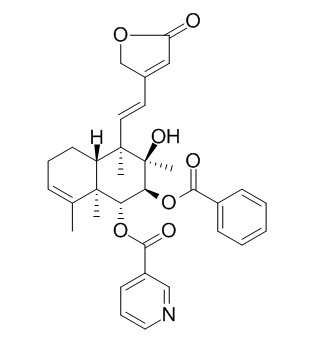Scutebarbatine B
Scutebarbatine B shows weak cytotoxicity with IC50 values ranging from 35.11 to 42.73 uM against K562 cell lines and HL60 cell lines.
Inquire / Order:
manager@chemfaces.com
Technical Inquiries:
service@chemfaces.com
Tel:
+86-27-84237783
Fax:
+86-27-84254680
Address:
1 Building, No. 83, CheCheng Rd., Wuhan Economic and Technological Development Zone, Wuhan, Hubei 430056, PRC
Providing storage is as stated on the product vial and the vial is kept tightly sealed, the product can be stored for up to
24 months(2-8C).
Wherever possible, you should prepare and use solutions on the same day. However, if you need to make up stock solutions in advance, we recommend that you store the solution as aliquots in tightly sealed vials at -20C. Generally, these will be useable for up to two weeks. Before use, and prior to opening the vial we recommend that you allow your product to equilibrate to room temperature for at least 1 hour.
Need more advice on solubility, usage and handling? Please email to: service@chemfaces.com
The packaging of the product may have turned upside down during transportation, resulting in the natural compounds adhering to the neck or cap of the vial. take the vial out of its packaging and gently shake to let the compounds fall to the bottom of the vial. for liquid products, centrifuge at 200-500 RPM to gather the liquid at the bottom of the vial. try to avoid loss or contamination during handling.
Phytomedicine.2019, 55:229-237
Korean Herb. Med. Inf.2020, 8(2):233-242.
Antioxidants (Basel).2023, 12(2):447.
Antioxidants (Basel).2021, 10(10):1620.
J Pharmaceutical Research Int.2021, 33(41A):275-284.
Appl. Sci.2020, 10(8),2804
VNU J Science: Med.&Pharm. Sci.2024.2588-1132
Food Sci Biotechnol.2024, 33(15):3629-3637.
Cancers (Basel).2021, 13(9):2223.
J Hepatocell Carcinoma.2022, 9:327-341.
Related and Featured Products
J Asian Nat Prod Res. 2013 Sep;15(9):941-9.
Bioassay-guided isolation of neo-clerodane diterpenoids from Scutellaria barbata.[Pubmed:
23909895]
METHODS AND RESULTS:
Bioassay-guided isolation of the aerial part of Scutellaria barbata yielded three new neo-clerodane diterpenoids scutebatas P-R (1-3), together with two known ones: scutebata E (4) and Scutebarbatine B (5). The chemical structures of the isolated compounds were elucidated by spectroscopic methods (NMR and MS) and by comparison with the spectroscopic data reported in the literature.
CONCLUSIONS:
All compounds except 3 showed weak cytotoxicity with IC50 values ranging from 35.11 to 42.73 μM against K562 cell lines, and compounds 1, 2, and 5 also displayed weak activities against HL60 cell lines.
Zhongguo Zhong Yao Za Zhi. 2015 Jan;40(1):98-102.
Diterpenoids from Scutellaria strigillosa.[Pubmed:
25993796]
METHODS AND RESULTS:
By means of preparative HPTLC and column chromatography over silica gel and Sephadex LH-20, nine diterpenoids were isolated and purified from the whole plants of Scutellaria strigillosa. Based on the physico-chemical properties and spectral data, their structures were elucidated as: 6-O-acetyl-7-O-nicotinoylscutebarbatine G(1), 6-O-nicotinoyl-7-O-acetylscutebarbatine G(2), 6,7-di-O-nicotinoylscutebarbatine G(3), scutebarbatine K(4), Scutebarbatine B(5), 6-O-acetylscutehenanine A(6), 6-O-nicotinoylbarba- tin A(7), 6,7-di-O-acetoxylbarbatin A(8), scutebarbatine F(9).
CONCLUSIONS:
Compound 1 is a new diterpenoid, and compounds 2-9 were isolated from Scutellaria strigillosa for the first time.



